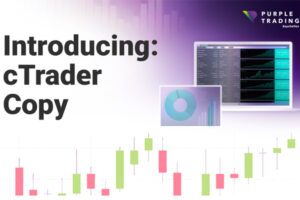Diversification of investments in the Forex market
Investment diversification is a fundamental element used by large financial investments (and not only), also on Forex market. Without it, in the long term most of them would be doomed to failure or translate into a significant increase in risk. What is this mysterious concept?
quoting Wikipedia:
"Diversification - diversifying the range of production or services to reduce the risk in running a business. By diversifying, not only is the likelihood of loss reduced, but the likelihood of the highest profit is also reduced".
Translating this into the world of financial markets, diversification is about spreading your investment capital across multiple different sources. In universities, this topic is often referred to as "do not put all your eggs in one basket". This means that you should not commit all of your capital to one stock. By spreading the risk into many trades, strategies, intervals and markets, the probability of bankruptcy or suffering a severe loss in the long term decreases significantly. Yes, the potential profits are also decreasing, but should the rate of return really be the most important for us? There is a market saying:
"You can earn 1000% but only lose 100%."
When you choose to trade with Social Trading websites, signal providers or PAMM accounts, we limit the possibilities of position management, and we completely give up the possibility of indicating the place and time of the transaction (assuming that we do not invest ourselves). This makes diversification even more important, if not the most important. Choosing the right signal provider will only reduce the risk to some extent. On the other hand, the selection of several carefully selected suppliers will make this risk sufficiently low.
How many suppliers to choose?
Unfortunately, there is no golden number here that could be pointed out. Theoretically, the more the better, however, or necessarily? If we decide on 20 signal providers, then the risk indicator will probably be very low. Unfortunately, the potential profits can also be so and we can lead to a situation in which we risk little, but also earn a little. Ultimately, it comes out the same as if we were investing in bonds or treasury bills, and that's not the point. On the other hand, when deciding, for example, only on two suppliers, we will limit the risk only to a small extent.
The selection of their quantity should depend on:
- the level of risk we accept,
- the number of transactions concluded by the supplier (if one supplier concludes 1 transaction per week, and the other 10 per week, such diversification of investments will be ineffective),
- held capital allocated for investments (with a small deposit and opting for many suppliers, there will be a problem with effective capital management).
Considering these factors, we should be able to individually determine the appropriate number (or range of them) of suppliers who will effectively reduce the risk while maintaining earning potential.
Investment diversification and signal providers
How we should choose signal providers, what to pay special attention to and how to configure the account for them are issues that will be presented in a separate article. However, here I will pay attention to what needs to be done for these providers to diversify the risk instead of increasing it.
In order for the risk to be proportionally distributed, it is necessary to select suppliers that generate a similar number of transactions. If we decide on two suppliers, where one opens one position a month and the other five a day, such diversification will not help us much. The positions of the second trader will continue to dominate. In such a situation, it would be necessary to choose a few more such suppliers as the former. Alternatively, we can look for the second that generates a smaller number of transactions.
It is also worth paying attention to which instruments the suppliers play. If we decide on three traders, where all deal only EUR / USD transactions, although they may play in different ways, they will be dependent on the characteristics of this single market (if the volatility in a given time interval drops on this pair, we will clearly feel it). The less correlated the instruments on which the suppliers we choose play, the smaller the risk factor.
Investment diversification and time perspective
Diversified time intervals will also positively reduce the risk. Suppose we decide to have two providers that invest in the same currency pair. The previous paragraph says it's not a very good idea. However, if they both perform well and invest in a different time horizon, the risk will be spread to some extent.
Delivering traders rarely reveal their strategies, or at least their details. If they did, there would be no need to share their own efforts. The general characteristics of the strategy are enough information for us, which will be useful when differentiating signals. There are less and more risky strategies. With less and more aggressive inputs (e.g. entering corrections vs. the so-called catching a falling knife). If we want to reduce the risk, it is worth paying attention to the advantage of the first type.
There are strategies that are based on adding successive positions by averaging the entry rate, so-called grids i matringales. Even though they are perceived as very risky, you don't have to give them up. With many signal providers where capital is distributed among them, such a strategy can effectively increase our revenue. And this while maintaining a rational level of risk.
Remember, the greater the variation in parameters from the characteristics of selected signal providers, the more diversifiable the diversification will be.






















![Forex Club – Tax 9 – Settle tax on a foreign broker [Download the Application] Forex Club - Tax 9](https://forexclub.pl/wp-content/uploads/2024/02/Forex-Club-Podatek-9-184x120.jpg?v=1709046278)
![Trading View platform – solutions tailored to the needs of traders [Review] trading view review](https://forexclub.pl/wp-content/uploads/2024/03/trading-view-recenzja-184x120.jpg?v=1709558918)
![How to connect your FP Markets account to the Trading View platform [Guide] fp markets trading view](https://forexclub.pl/wp-content/uploads/2024/02/fp-markets-trading-view-184x120.jpg?v=1708677291)
![How to invest in ChatGPT and AI? Stocks and ETFs [Guide] how to invest in chatgpt and artificial intelligence](https://forexclub.pl/wp-content/uploads/2023/02/jak-inwestowac-w-chatgpt-i-sztuczna-inteligencje-184x120.jpg?v=1676364263)



![Izabela Górecka – “Success on the market depends not only on knowledge, but also on emotional stability” [Interview] Izabela Górecka - interview](https://forexclub.pl/wp-content/uploads/2024/04/Izabela-Gorecka-wywiad-184x120.jpg?v=1713870578)
![WeWork – the anatomy of the collapse of a company valued at $47 billion [WeWork, part II] wework bankruptcy story](https://forexclub.pl/wp-content/uploads/2024/04/wework-bankructwo-historia-184x120.jpg?v=1711729561)
![Adam Neumann – the man who screwed up Softbank [WeWork, part AND] adam neumann wework](https://forexclub.pl/wp-content/uploads/2024/04/adam-neumann-wework-184x120.jpg?v=1711728724)





![The most common mistakes of a beginner trader - Mr Yogi [VIDEO] Scalping - The most common mistakes of a beginner trader - VIDEO](https://forexclub.pl/wp-content/uploads/2024/03/Scalping-Najczestsze-bledy-poczatkujacego-tradera-VIDEO-184x120.jpg?v=1711601376)
![Learning patience: No position is also a position - Mr Yogi [VIDEO] Scalping - Learning patience - No position is also a position - VIDEO](https://forexclub.pl/wp-content/uploads/2024/03/Scalping-Nauka-cierpliwosci-Brak-pozycji-to-tez-pozycja-VIDEO-184x120.jpg?v=1710999249)
![When to exit a position and how to minimize losses - Mr Yogi [VIDEO] Scalping - When to exit a position and how to minimize losses - VIDEO](https://forexclub.pl/wp-content/uploads/2024/03/Scalping-Kiedy-wyjsc-z-pozycji-i-jak-minimalizowac-straty-VIDEO-184x120.jpg?v=1710336731)


















